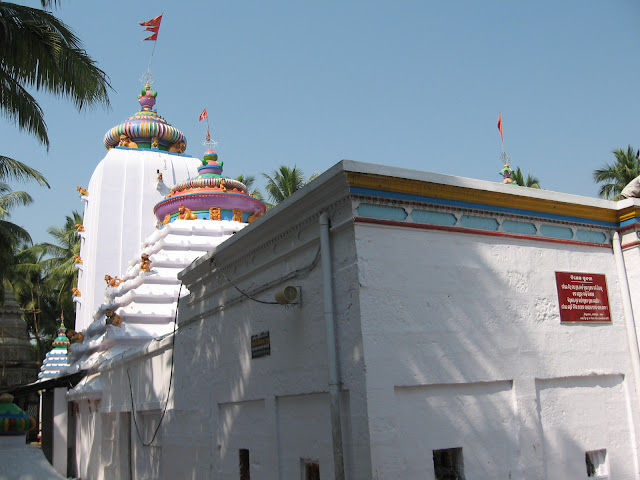 |
| Paika Akhada members perform at PMG Square in Bhubaneswar |
Paika Nrutya, the traditional battle dance of the State, might have withstood the test of time, but the number of akhadas (training centres) in Odisha is gradually on the decline. Blame it on an apathetic Government, lack of promotional avenues and funding.
The dance revolves around acrobatic movements with swords, lathis (sticks), chakras (wheels) and dhalis (shields) to the accompaniment of 'Chagi', 'Mahuri', 'Nagara' and cymbals. In the ancient times, Paika Nrutya by the warriors was considered a rehearsal for the battle.
Scholars have compared Paika Nrutya to Kalaripayattu of Kerala, considered the oldest fighting system in existence, because of its approach to traditional weapons and techniques, but the former does not enjoy the patronage that the latter does. In fact, Kerala has been successful in converting Kalaripayattu into a tourism product whereas in Odisha, Paika Nrutya is limited to a handful of villagers in rural areas.
Today, Paikas can only be seen performing during Dussera, Kali Puja, birth anniversary celebration of Harekrushna Mahatab and the Dhauli Kalinga Mahotsav. Besides, the Jobra puja committee at Cuttack has been organising Paika Nrutya competitions every year on Vijaya Dashami day from 1921.
History Behind the Form
The martial prowess of Paikas finds mention in Sarala Das' 'Mahabharata', written in the 15th century, poet Balaram Dash' work 'Jagamohan Ramayan' and even in the carvings on the Sun Temple at Konark. Historians said when the British started meddling with the revenue system of the State in 1803, the farming community rose in rebellion. At that juncture, Bakshi Jagabandhu Bidyadhar, the military chief of the King of Khurda, revolted on April 2, 1817. As Bidyadhar led his army of Paikas, the British were forced to retreat. The rebellion came to be known as Paika Bidroh. Also, it was due to the Paikas that the Britishers did not find it easy to win over the Barunei Fort at Khurda, which is said to be the last free fort of the country to go to the British.
Successors of the Fighter Tribe
While officially, there is no information on the exact number of akhadas existing in the State today, unofficial sources put the number of Paikas still practicing the martial dance form at around 20,000 in the districts of Khurda, Dhenkanal, Ganjam, Puri, Gajapati, Talcher and Balasore. The maximum number of akhadas exists in Khurda. "If the Nrutya is performed today, it is because of the stage shows that offer money for sustenance. There is no encouragement from the Government's side," says Gyana Ranjan Mohanty, a Puri-based acrobat who performs Paika Nrutya and Malkhamb. He says the existing forms of Malkhamb, Sahi Yatra, Ranapa, Dhemsa, Chhau and Naga Nacha have been born out of Paika Nrutya.
Dance or a Sport?
Ileana Citaristi, who has authored a book 'Traditional Martial Practices of Odisha' and carried out extensive research on the subject, feels Paika Nrutya is currently in a no man's land. Government is yet to classify it as a performing art or a form of sport as a result of which, it does not come under either the Sports Department or Culture Department. “This is why, no one pays attention towards it propagation and whatever little is being done for its promotion is half-hearted," she says, adding that although Paika training exists in rural areas of the State, it is not systematic. Not all the Paikas are adept in every form of the martial dance. "Only a few can play with a sword and shield today. You will not find the entire gamut of the martial art in any of the akhadas; what can be seen is mostly martial exercises like Banati, Lathi Khela, Chakra Ladhei, pyramid formation and somersault," Ileana adds.
No Paika Training Centres
Currently, there are no Government training centres where Paikas can be trained. Even as a training centre for Paikas was opened by the Government at Gurujang near Khurda in 1998, the institution did not function beyond two years. The akhadas do not have a curriculum and all forms of martial exercises in Paika Nrutya are not covered as far as training is concerned.
Founder-Director of Rani Sukadei Regiment of Talcher, the only all-women Paika Akhada in the State, Soubhagini Debi who is also the principal of Silpanchal Women's College in Talcher, says Paika Nrutya, which is an integral part of Odisha's history, should be presented at important State festivals so that today's youth come to know about it. "It is a dying art form and only some Gurus have kept this tradition alive. There is a need for establishing training centres for Paikas with provision of scholarship for youths who wish to learn it. Whatever training is being imparted now is at individual level and we do not know if our students would be interested in carrying forward the tradition," she says.
Commemorating Paika Rebellion
Culture Minister, Ashok Panda, who admitted to the lack of patronage to Paika Nrutya, said in commemoration of 200 years of the Paika rebellion that will be observed in 2017, the Culture Department has planned a series of events with the Paikas. "Also, we will be taking steps for protection and conservation of Khurdagarh fort, and Barunei that was the religious place where Paikas used to worship before setting out for war," he informs.
































































